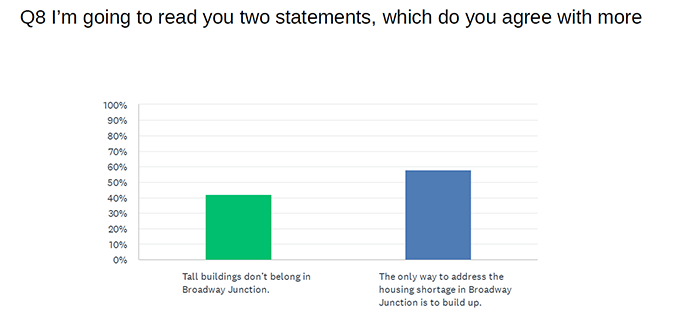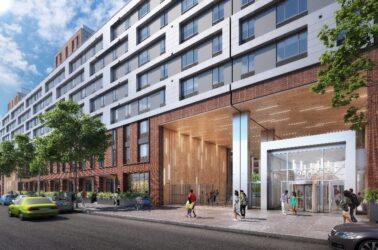It’s no secret that East New York has experienced a dramatic transformation in the last decade. From the significant increase in homes to the surge in development projects, the neighborhood has put itself on the path to becoming a more modern and vibrant place to live and work. While the landscape of the neighborhood evolves, there is value in looking ahead and putting thought into action.
Over the summer, the Local Development Corporation of East New York undertook a survey initiative to engage local residents, commuters, business owners, and passerbys regarding their thoughts and feelings on the area around Broadway Junction, the neighborhood’s major transit hub and one of the largest in the city. More than 300 responses were collected in collaboration with Good Shepherd Services and high school seniors and college freshmen surveying people around the station.
To set the scene, let’s first take a look at one of the catalysts for the area’s change – the East New York Neighborhood Plan, which was designed to ensure an increase in affordable housing, economic development, and community resources.
A Look Back at the East New York Rezoning
While this past decade has seen massive shifts in neighborhood infrastructure, ultimately making East New York a more desirable place to call home, it hasn’t been an easy road. With a consuming history of poverty and neglect, East New York development has faced numerous challenges.
A comprehensive plan centered around the neighborhood was created in the form of the East New York Neighborhood Plan to facilitate housing preservation and creation, promote economic development, set up streets devoid of environmental hazards, and invest in community resources that support the long-term growth and sustainability of East New York, Cypress Hills, and Ocean Hill.
The plan was developed through a robust community engagement process and close collaboration with residents, stakeholders, and elected officials. The new zoning concept was later conceived by the Department of City Planning (DCP) with the expectation that these changes would see the advent of affordable and mixed-income housing and community facilities, promote commercial development, and improve neighborhood connectivity.
Approved by the City Council on April 20, 2016, after undergoing various modifications – some key features of the zoning changes included:
- Mapping residential and commercial zoning districts along the central corridor of Atlantic Avenue, which allows maximum permitted heights of 12-14 stories.
- Mapping residential and commercial zoning districts along Pitkin Avenue, Fulton Street, some areas in Liberty Avenue and Ocean Hill to facilitate mixed-use development with the maximum permitted heights of 6-10 stories.
- Mapping Special Enhanced Commercial Districts on key corridors to require that all new development includes non-residential ground floor uses such as stores or community facilities to create active, pedestrian-friendly streets and provide needed neighborhood services.
- Establishing the City’s first Mandatory Inclusionary Housing Area, which requires all new residential development, and includes permanent affordable housing.
- Creating a new Mixed-Use special district along Liberty Avenue, parts of Atlantic Avenue, and some areas in Ocean Hill to allow industrial uses to continue along with new residential and commercial services.
Reimagining Broadway Junction
Core to the rezoning plan was a vision for reimagining Broadway Junction, one of the city’s great transit nodes, into a more accessible and dynamic transit hub and economic center. But only in recent years has Broadway Junction experienced notable increases in public and private investment since the rezoning. From the development of 2440 Fulton Street, which will host 1,100 NYC Human Resource Agency employees, to the State’s planned Interborough Express, East New York is now starting to command attention with a large number of recently completed and upcoming projects.
Despite initial excitement and investment, the East New York rezoning plan has since faced roadblocks, including the slow pace of development of new affordable homes and the promise of 3,900 new manufacturing jobs in the rezoned industrial business zone that have not come close to fruition. In fact, local employers, like the bus companies operating out of large lots in Broadway Junction, seem to have lost employees in a trend accelerated by the pandemic. So while East New York’s rezoning represents an opportunity for the neighborhood to flourish, community members are understandably skeptical as progress has stagnated in the last few years.
Broadway Junction is central to East New York’s evolving landscape, validating the need that those building in the community must understand, respect, and provide the resources truly needed for its people. More than ever, it is critical to begin gathering data to inform future iterations of the plan, ensure future developers improve on the goals established over decades of ENY rezoning studies, and understand the emotional and physical impact of such potentially transformative zoning changes.
Notable findings from LDC ENY’s Summer Survey
In that vein, the survey conducted this summer by the Local Development Corporation of East New York (LDC ENY) aimed to provide insight into people’s views concerning Broadway Junction and the surrounding East New York community.
“This is a critical time for the neighborhood in its future growth and development,” said LDC ENY Executive Director Bill Wilkins. “We want to engage the community to be a part of shaping what is to come.”
Some notable findings from the survey included the following:
A Need for Change
As the saying goes, “the only constant thing in life is change.” The survey findings uncovered an earnest desire for development in the area, with 80% of respondents expressing the need for change in Broadway Junction.

Housing and Job Shortage are Top Concerns
Roughly half of those surveyed expressed concern about housing and job accessibility in Broadway Junction.
“Job shortages have long plagued the community, resulting in individuals being unable to access basic amenities,” said Wilkins. “Unfortunately, the effects of the pandemic have only exacerbated these conditions for many.”

“Building Up” Answers the Call for Efficient Housing
A staggering 57% of individuals believed that ‘building up’ can address the housing concerns in the community.
“Scale brings opportunity not only to address the housing shortage in Broadway Junction, but also infuse more resources and additional funding into programs that benefit neighborhood residents,” said Wilkins.

Desire for Affordable and Accessible Housing
Survey respondents were asked to choose from three housing options they would like to see built around Broadway Junction. According to the data, respondents ranked affordable (71%), supportive (49%) and senior housing (44%), as the most needed in Broadway Junction.

Looking for Staying Power
The survey showed almost half of respondents either live in Broadway Junction or were commuting through.
It also reflected the low number of Broadway Junction residents working within its environs (12%), demonstrating the need for more jobs to be created within Broadway Junction and also the need for more entrepreneurs as (<1%) of residents owns a business in Broadway Junction.

Attractive and Useful Local Amenities
The survey allowed respondents to suggest what services they’d want to see to give Broadway Junction a facelift. After filling out the survey, (47%) chose a much bigger supermarket, (33%) opted for a gym facility, while (and 27%) longed for retail shopping complexes in the community.

Join the Conversation: East New York’s Movers and Shapers
East New York has seen considerable development since the zoning changes and has long evolved into a community with a booming housing sector and a thriving economy. However, there is still room for improvement.
In the coming month, the LDC of ENY will expand its local surveying to ensure all East New Yorker’s are represented – from Broadway Junction commuters to the greater East New York and Central and East Brooklyn communities.
Care to join the conversation? Click here to fill out the online survey, and become an East New York Mover and Shaper. The future of East New York lies in our hands – so, let’s do this together. Your feedback is important in our journey to an exciting future for East New York.

















Leave a Reply